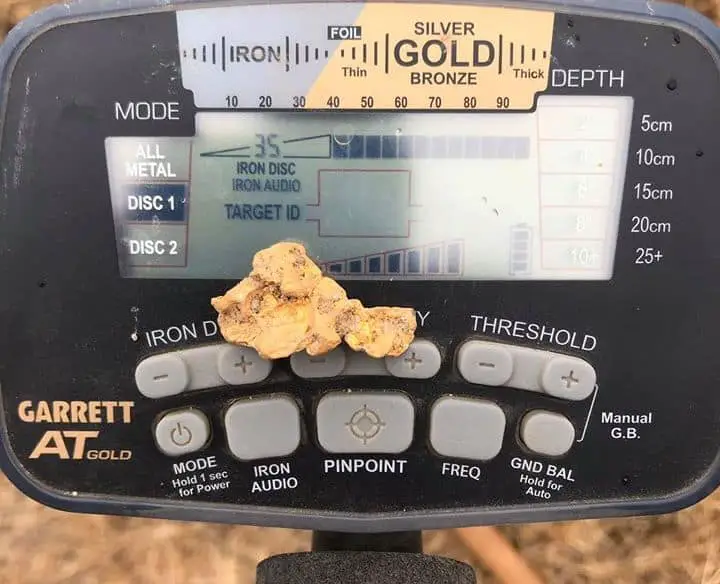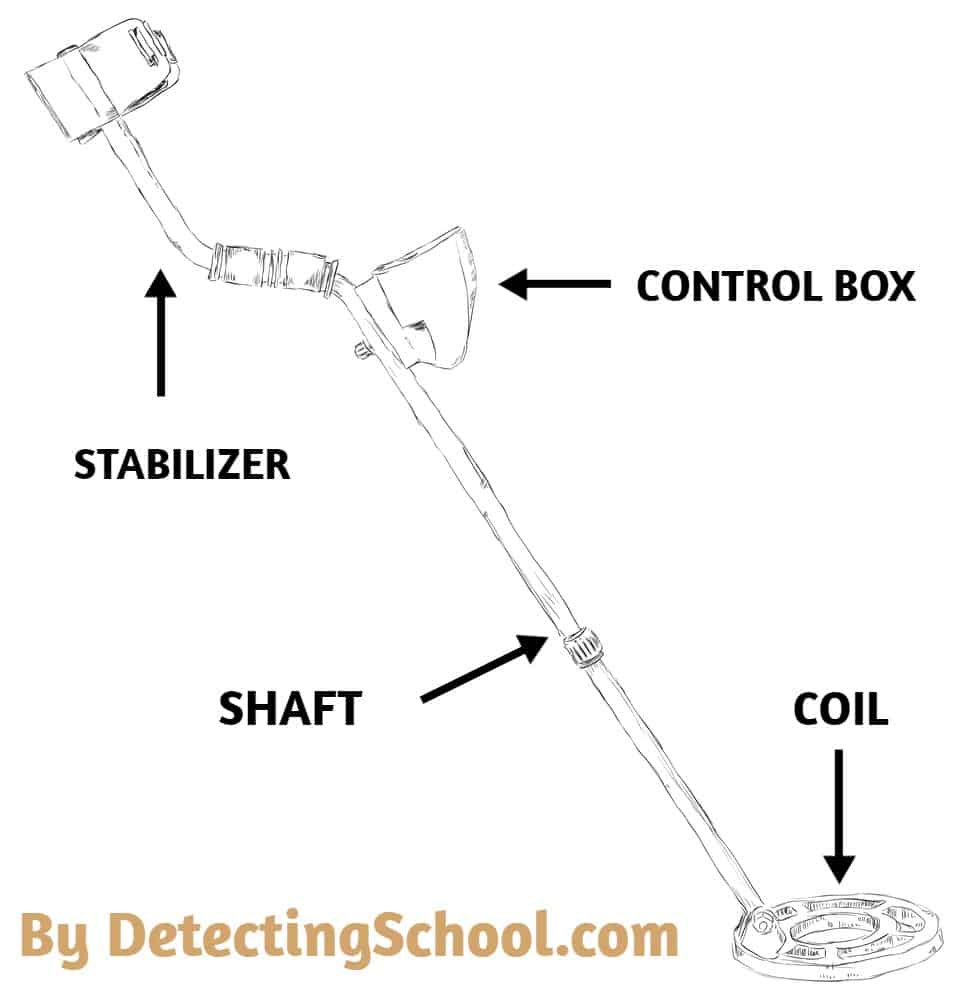
Gold detectors are nothing but a metal detector where the manufacturer has added additional features and settings that help finding precious metals like Gold …
However, it is still very important even for hobbyists like us to understand how these machines work. Having such understanding will help you get the most out of it so you can, hopefully, end up with more gold targets.
In this article, I breakdown how gold detectors operate; don’t worry, I won’t make it complicated; I will use simple words to help explain the concept and the most important features/settings you need to be aware of.
How Gold Detectors Work in General? (little technical but useful)
Gold detectors work by transmitting an electromagnetic field into the ground. This field transmitted induces loops of electrical current, known as eddy currents, within conductive materials or metals. And since gold is a conductive material, it the electromagnetic field will trigger electrical current in it, which will make the machine react to it and then let you know that there is probably gold underneath the ground.
Keep in mind that this is the same principle for regular detector, yet Gold detectors are calibrated and optimized for gold prospecting.
Indeed, gold detectors take this process a step further as they measure inductance and conductivity as well.
Inductance refers to the amount of eddy currents that are produced by the target. Conductivity is how easily these currents flow.
Gold detectors measure the size of the eddy currents and how fast they are traveling. By doing this, they are able to calculate the time constant of the target in the ground.
Time constants differ considerably between targets. For example, bits and pieces of aluminum foil have very short time constants, while gold rings and coins have long time constants.
Scraps of iron, steel, and other ferrous metals have even longer time constants. Gold detectors can be calibrated to specifically look for targets that fall within the middle range.
However, this is not a sure shot method of detecting gold as the shape, size, and distance of a target and other environmental variables have an impact on the accuracy of the detector’s time constant calculation.
To compensate for this, you can re-calibrate gold detectors to search for a narrower or broader range of time constants.
FYI: If you’ve never seen a gold machine before, or not sure about what it looks like, then you can have a look at this quality model. This is by the way, one of the most popular gold machines in the market, as far as I know.
Main components of gold detectors …

A gold detector that works on electromagnetic technology consists of the following parts and components:
- Control Box: Which is the brain of the machine. It contains the battery, device controls and settings, the readout, speakers, and the microprocessor.
- Stabilizer: This attachment is part of the detector that makes it comfortable for you to use for long hours. It is basically the armrest of the device. It keeps the metal detector stable as you move it around.
- Shaft: It is the main part of the machine that all of the other parts connect to. It is usually possible to adjust the shaft as per your comfort.
- Search Coil: Located at the bottom half of the detector, it is an antenna that contains the search coils that are critical for the machine to be able to detect gold.
Many other models of metal detectors also have a jack for connecting headphones, while some others have the control box located below the shaft, with a small display unit above.
Gold detectors in VLF technology typically have two coils inside the search coil. These are:
- Transmitter Coil: This is the outer coil loop, and it contains a coil of wire inside. Electricity is passed along this wire, first in one direction and then in the other. Electricity passes through the wire thousands of times each second. The number of times the current direction changes every second is what establishes the frequency of this coil.
- Receiver coil: This is the inner coil loop that contains another coil of wire. This wire functions as an antenna and picks up and amplifies the frequencies coming from the target objects in the ground.
Main features of gold detectors …
Gold detectors are slightly different from your typical detectors. Gold detectors have generally these features:
- Operate on High frequencies: regular detectors usually operate on low or medium frequencies simply because they are usually meant to find regular sized objects. However, gold machines are usually meant to find small sized items that are mostly gold. And this won’t be really possible unless it operates on significantly higher frequencies. Learn more about metal detector frequencies by checking this article.
- Operate on multiple frequencies at the same time: This is not the case for all gold detecting machines. This is generally the case for the most recent/modern ones. Indeed, operating on multiple frequencies at the same time is literally like having multiple metal detectors searching at the same time which makes your quest even more effective and efficient.
- Superior ground balance: Ground balancing could sound like a complicated concept if you are learning about it for the first time. However, it is pretty simple. In fact, sometimes you are dealing with highly conductive soil rich in minerals. These generally cause false signals which would confuse you. Ground balance is this magic feature that will let your machine be aware of the level of mineralization that a given ground has. Thus, it will trigger little to no false signals which will help you focus solely on the valuable items you are actually looking for. Keep in mind that gold in its raw form is usually located in highly mineralized ground thus the utility of this feature. Learn more about ground balance by checking this article.
- Solid discrimination: This concept is similar to ground balance, but it rather addresses trashy areas where there is lot of iron stuff thrown around. Setting discrimination feature will simply tell your machine to ignore ferrous (junky) metals and focus on potential valuable ones.
- High sensitivity: Again, gold targets like nuggets are usually small is size. If your machine lacks sensitivity, then it won’t be able to see it. Gold detectors are extremely sensitive to smaller metals.
Keep in mind that those feature are also very important to Detect White Gold!
Example of a Gold Detector
Minelab Gold monster 1000 (Check it Here at Amazon) is known as one of the best machines for finding gold. It is an all-terrain model that has an operating frequency of 18 kHz+, comes with a digital target ID, has manual and automatic ground balance, iron audio, and a separate built-in pinpoint mode.
It has high-quality discrimination capabilities. It is geared towards both beginners and medium-skilled detectorists, and it has also shown excellent results when used by professionals for gold-seeking.
What makes gold detectors different from regular detectors?
Detectors that are best suited for gold detection will operate at much higher frequencies, typically between 15kHZ – 61kHZ, whereas hobby metal detectors usually operate at lower frequencies between 6.5kHZ – 14kHZ.
Gold detectors can operate on high frequencies and in challenging ground conditions by picking up gold even in small sizes. At the same time, they do a great job when it comes to discrimination.
Also, the coil size for a gold detector is smaller than average. This allows them to be sensitive to smaller targets. The latter are usually sub-gram in weight.
The smaller the coil, the smaller the metal that it will be able to detect, including small gold flakes.
How deep can gold detectors detect?
Gold detectors do not have a very high depth, especially if it is equipped with a monoloop coil. However, got those gold detectors that have DD (Double-D) coil, the depth could be a bit higher.
For example, the Minelab Gold Monster 1000 has a depth of around nine inches with a monoloop coil and around 12 inches when equipped with a Double-D one.
It has also the same depth with a monoloop coil, and with a Double-D coil, it is able to perform to a depth of 14 inches. However, the good part about using gold detectors is that this depth remains stable.
The depth does not change even when you use it in the worst ground conditions.
Ideal frequency range for gold detectors …
Again, gold detectors operate on a higher frequency than typical machines …
This allows the detector to pick up those very small low conductor targets with ease. Generally, all detectors can pick up gold, but not as well as those that are specifically designed for gold.
Gold detectors have a higher frequency that is usually around 18khz, sometimes much higher. If you decide to spend the big bucks on a gold detector, this could even reach up to 70 kHz.
Final Thoughts …
I know there are some technical concepts here that might be a little complicated if you are learning about them for the first time …
Don’t worry too much about that, everything will start making sense after a little while.
Most important thing in my opinion is to get started in your quest for Gold or whatever target you are looking for. Again, all these features and settings will start making sense pretty quickly …
The only thing you need to have in mind is to target locations where it is proven to find gold. An example is around creeks where there have been gold rushes before. Don’t target locations where gold was never found before.
